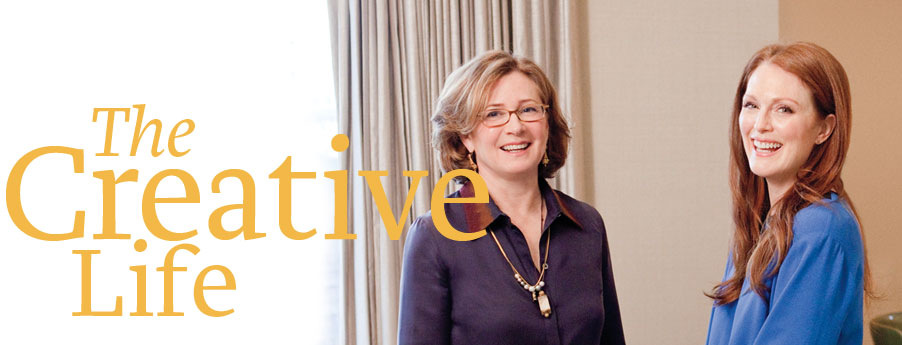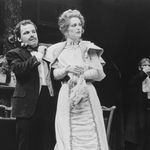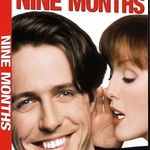The Creative Life
Actor Julianne Moore and creative director Gael Towey talk about the arts, storytelling, and where they find inspiration.
Edited by Corinne Steinbrenner; Photo by Matthew Hranek
Their Manhattan homes are mere blocks apart, and they’re each mothers of two children. They both attended BU’s College of Fine Arts, and they share interests in storytelling, interior design, and healthy cooking.
When Academy Award–nominated actor Julianne Moore (’83) and Gael Towey (’75), the longtime creative director at Martha Stewart Living Omnimedia (MSLO), first met at a CFA alumni dinner, it was clear they had much in common—not least, their status as highly accomplished and multitalented women.
Moore—known for her intelligence, versatility, and distinctive red hair—has appeared in more than 50 films, ranging from the 1998 cult favorite The Big Lebowski to 2010’s critically acclaimed The Kids Are All Right. Her acting has earned her a Daytime Emmy, six Golden Globe nominations, and four Oscar nominations. In addition, her interior design talents have been featured in The World of Interiors magazine, and her popular Freckleface Strawberry children’s book series has inspired a successful off-Broadway musical.
After serving as design director for House & Garden magazine, Towey joined Martha Stewart Living in 1990 as its founding art director. She designed the magazine’s inaugural issue, establishing its iconic and award-winning visual style, and then moved into progressively larger roles at MSLO, directing the design of everything from magazines and books to home furnishings and merchandise. This year she accepted a new title as chief integration and creative director, overseeing the creation of digital magazines and mobile applications for the multimillion-dollar Martha Stewart brand.
The College of Fine Arts recently brought Moore and Towey together again—this time for an exclusive Esprit interview. Moore took a break from a busy schedule promoting the HBO movie Game Change, in which she portrays former Alaska governor Sarah Palin, for a casual conversation with Towey about arts education, raising children to be creative, and living a life in the arts.
Towey: You were an acting student at Boston University in the 1980s. Are there things you call upon that you learned at BU that are still important to you in your everyday life as an actress?
Moore: Absolutely. I had a variety of sources to draw from while I was there. Different techniques and methods were taught each year, and the one thing that I came away with is that there is no one method to acting, to performing. You have to find it yourself. You spend four years with some teachers you really respond to, and then there are other teachers whose methods you don’t respond to. At the end of the four years, you realize what you like and what works for you. So, absolutely, there are things that became fundamental to my acting.
Towey: Yes, it gave you a foundation. I was thinking about how, especially having children in college myself, so much of your education depends on what you bring to it as a student. I don’t know if all students realize the responsibility they carry when they go to university and how important it is for them to make choices and open themselves up to possibility.
Moore: I don’t think they do. I was at BU not long ago and spoke to some acting students. I talked to them about what was expected of them when they got out of school, but I think they should require those same things of themselves while they’re in school. I try to say it to my children even now. When my daughter says, ‘I don’t want to do this homework,’ I tell her, ‘Then don’t do it. Don’t do it and go in tomorrow and tell your teacher that you didn’t want to do it and didn’t finish it.’ Of course that makes her very upset, but I’m just trying to ask her to take responsibility. By the time you’re in college, you need to say, ‘I’m going to take responsibility for what I want to do and how I’m going to accomplish it.’
Towey: I think that’s true of visual artists, too. You have to open yourself up to take risks. Being willing to fail is important.
“It’s never a sure thing. As a musician, as a visual artist, as an actor—you have to be able to know you’re going to fail, and fail a lot.”
Moore: And you have to be brave about it. I talked to my daughter about this the other day, too, because she and her friends were all trying out for parts in a play. And one little girl said, ‘Well, you can’t get your hopes up because you might be disappointed.’ And I said, ‘No, you can get your hopes up. You should get your hopes up. You just have to be brave, because you might not get the part, and that’s going to be really disappointing, and it’s going to feel terrible. But you have to be brave enough to do it again, to try again.’ I think that’s what it’s about in the arts in general, because it’s never a sure thing. As a musician, as a visual artist, as an actor—you have to be able to know you’re going to fail, and fail a lot.
Towey: And it’s hard to find that inner resource. I think it actually takes a lot of practice. With your father in the military, you were brought up all over the world. You were in a new school almost every single year. Obviously, that had a big impact on how you approach life. I can imagine you felt as though you had to test those inner resources every time you walked into a new school and tried to make new friends.
Moore: I did, and the thing I learned is that behavior is not character. Behavior is mutable. I think that when you stay in the same place, you believe that behavior is a static thing, that it’s part of who you are. It’s not. It changes from place to place. What’s universal is a different sort of thing—it’s deeper. Universal truth—something that everybody shares regardless of language, culture, behavior—I’m always looking for that within a narrative.
Towey: Storytelling is such an important part of our lives. In the magazine business, that’s what we do, and that’s obviously what you’re doing, too.
Moore: And you’re doing it visually. That’s something that I tell acting students: look at the frame; don’t just hear the words. If someone has chosen to frame something a certain way and placed actors within it, there’s a narrative there. Or, there’s a narrative within a collection of objects in a room and the way they’re placed.
Towey: You’re a very visual person, so I wanted to ask you about the movie sets you’ve worked on. What are some of your favorite sets?
Moore: A Single Man comes to mind.
Towey: The house that your character, Charley, lived in was so 1960s, sophisticated.
Moore: The style was very Hollywood Regency, yes. And George, played by Colin Firth, lived in a really modern, tiny Lautner house that’s actually in Pasadena. It’s always great to be on a set where someone has taken a lot of care in the storytelling and put real thought into who your character is and what they would have around them and what would be meaningful to them. That’s just fun. It fills in your story.
Towey: I want to segue to the subject of raising kids. Giving my children the ability to learn how to be creative is a huge part of my life, and it’s made my life with my children and my husband so fulfilling. My husband is a designer, and we share a lot. You and your husband are both in the film business, and you obviously have a lot in common. What do you do to make sure that your children have that creative life?
Moore: I feel that exposure is everything. I made both of my kids take piano when they were five. My son took piano for a year, and then he wanted to take guitar. I said, ‘You can’t quit piano yet. At the end of the year, you can decide.’ Well he decided guitar, and he stuck with it. And now he’s a teen, and he’s been playing guitar all these years. My daughter struggled through piano, struggled through guitar; that’s not her thing. So with each child, you’re going to learn what sticks. In terms of visual arts, you try to demystify it by talking to them and bringing them to museums.
Towey: And it’s all here in New York. It’s the best place in the world to bring up children—what they’re exposed to just on the street is so inspiring.
Moore: Yes, you can see street artists and say, ‘Look at that. See what this person has done. What does it look like? How would you draw it?’ Even with the books that I write, when I talk to little kids about them, I tell them, ‘I wrote the words. Someone else did the pictures. I’m sure you make books in school. You can make them by yourself and put the words and pictures together, or you can get a partner like I have.’ You try to demystify it so that the book is not just something that’s created somewhere out there. It’s something they can understand.

Freckleface Strawberry series covers
Towey: I wanted to ask you about your writing. You’ve been able to intermingle your creative life as an actress with that of being a writer at the same time.
Moore: Well, I’m not a novelist!
Towey: I know, but you’re telling stories. And did the lessons in the stories come out of your own personal experiences?
Moore: I think for most children’s book writers, it’s all autobiography. I always tell little kids that everything they say about my character’s freckles in Freckleface Strawberry, people said to me as a kid. Freckleface Strawberry and the Dodgeball Bully is really about my experience hating dodgeball. Best Friends Forever, which is the third book, is a metaphor for marriage. So, yes, they’re all things I wanted to talk about, but they’re written from a child’s point of view.
Towey: How did you find the courage to try your hand at writing, to branch out from acting and try something new?
Moore: Well, it doesn’t hurt to try. That’s what my mother always said. You might as well try. The worst thing that can happen is that you fail. And it’s painful, and it will hurt your feelings—and my feelings have been hurt many, many times—but what else are you going to do?
Towey: Exactly. And for young artists who are just beginning their careers, would you recommend they concentrate on a single craft until they’re more experienced, or should they branch out from the beginning?
Moore: This is interesting because when I was at BU last year, a student asked me this. He said, ‘What should I do? Should I diversify?’ and I said, ‘We’re talking about your life. When you get out of school, you’re thinking about career, career, career. But take a step outside that and realize that your career is just one part of your life.’ Diversification is not about getting ahead; it’s about what you enjoy. So, by all means, do what you want to do. There’s no right or wrong.
“I think a creative life is a whole life. In a creative life you never stop working. You’re always looking. You’re always learning.”
Towey: I agree. It’s about passion. If you let your passion lead you, you’ll discover the wonderful things you can do. I think a creative life is a whole life. In a creative life you never stop working. You’re always looking. You’re always learning. Lifelong learning is one of the most important things you can do for yourself and the people around you.
Moore: I think that’s absolutely true.
Towey: And you have to learn so much. I was reading about your recent Sarah Palin movie and about the technical part of learning a character. It’s similar with art: craftsmanship is tremendously important. You begin with a creative inspiration, but it’s the time you spend on the execution—your technical craftsmanship—that enables you to fulfill the original vision.
Moore: I’m glad you brought that up. That’s something people don’t always talk about—about the things you have to do technically. It gives you a framework. If you have an idea, an inspiration, it can pull you around all over the place. Until you have a framework for it, it goes nowhere. That’s where your technique comes in: it allows you to take the idea and to shape it and present it. That framework is what school is all about. It’s what I learned from my teachers—different techniques and ways to structure things. You don’t exist as a creative person without that.
Photo Gallery
Talent and Versatility
From BU theatre productions, to daytime soaps, to Oscar-nominated film performances, Julianne Moore has built an impressive acting career.




















